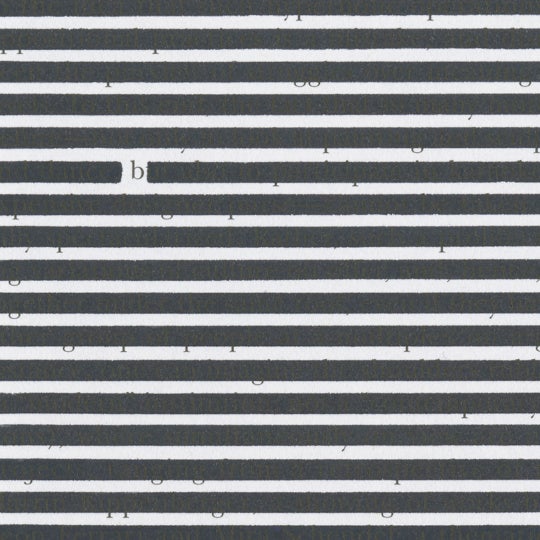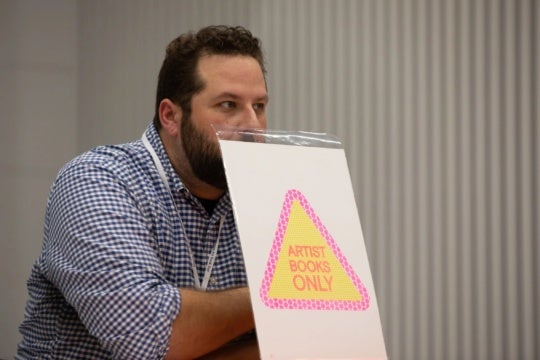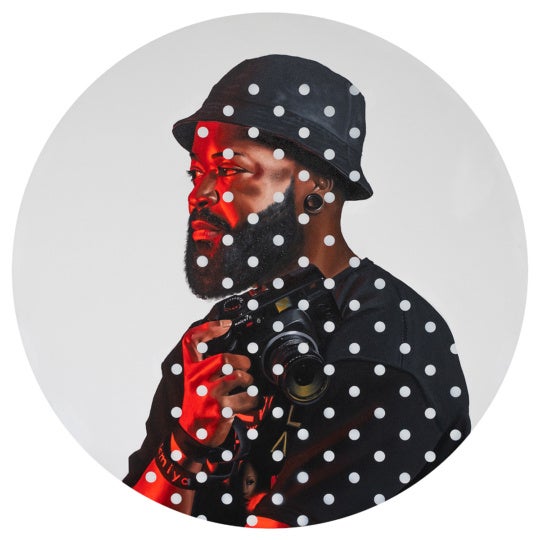
Atlanta artists Megan Mosholder and Justin Rabideau recently completed Sailor’s Valentine, an immersive, large-scale installation comprising salvaged two-by-fours, polypropylene rope, screw eyes and ultraviolet paint. Commissioned for Art on the BeltLine and located at the southeast corner of Piedmont Park, the installation reaches approximately 15 feet at its highest point. The stacked and secured two-by-fours curve to define an inviting concave space. Dozens of ropes fastened at strategic points on the sculpture and surrounding ground are brushed in UV-reactive paint so that they glow when illuminated with a black light. When viewed from the exterior, they peek through the two-by-fours’ serial monotony and suggest motion and projection. These common materials – the stacked wood breaking the rectangularity of its imposed shape, curving into organic forms as lines in space dash about in narration – achieves a tone of traversal. As ambling viewers round the arrangement’s convex exterior, away from the BeltLine’s bustle, the materials create a welcoming space of respite and seclusion.
The work’s title references a type of craft made by fixing numerous small seashells in pleasing arrangements, traditionally given by a sailor as a sentimental gift to his loved ones after returning home from a long voyage. Beyond calling attention to the artwork’s composition, the title suggests the sculpture as a thoughtful gift to a community.
In the wake of a soft opening marking the installation’s first illumination on August 31, Mosholder and I discussed the work’s concept and completion, the collaborative process, and the role Atlanta’s art community can play in the city’s changing urban fabric.

Jared Butler: First, Sailor’s Valentine takes a unique form. Can you summarize the work for me and discuss the juxtaposition of its materials, which I find to be among its defining features?
Megan Mosholder: This artwork was conceptualized and built as a meld of two artistic practices: Justin Rabideau’s and mine. Justin approached me in May or June and suggested that we collaborate on a piece together, and we both saw the BeltLine call to artists as the perfect opportunity.
Justin typically uses recycled materials [in his work], such as the two-by-fours. He began working this way after graduate school when he realized that most sculptural materials (steel, for example) were not only expensive but potentially wasteful, especially during grad school when most of the work you make is in the interest of honing your craft as opposed to actual, real work. I came to working with string and linear elements for similar reasons: to be able to travel inexpensively and with ease but still build monumental works. I also use light as a way to articulate space, a feature of my work that Justin was interested in. I’m interested in light as its own separate medium and the ways in which it can change and emphasize an artwork.
JB: How did you and Justin work together on this project? What was the process of installing on the BeltLine like?
MM: Justin and I worked collaboratively throughout the whole experience, critiquing our aesthetic decisions and making suggestions as the work was built. We began construction for the piece in the studio at Joe Bigley’s Level 7, located in East Point. The installation was built in sections so it could be easily dismantled and rebuilt. Then we loaded it up and took it to the BeltLine, where it was rebuilt. The final element was attaching screw eyes, tying rope, and hand painting the rope with UV.
JB: How would you define the public nature of your installations, and what are your goals in executing these works? What role do you think the particularities of Atlanta’s transitioning art scene and urban environment play in the development of your public installations?
MM: One of the reasons I’ve started working in the public sphere is to generate reliable income for myself. When I first finished graduate school and was attending residencies, I was struggling financially. My personal research, which mainly consisted of searching for grant money, showed that there were hundreds of calls to artists for permanent public works, and the average budgets for projects were $100,000 or more. It has become my goal to continue to work within the public realm as a way to support myself and my artistic practice I am also interested in the ways in which public artwork can change a city for the better. Studies show that public artworks help citizens to take pride in their community. The artworks contribute to an overall sense of well-being. I also love the idea of building work that will be seen by individuals who don’t frequent art museums or galleries.
As far as the art scene and its influence on my practice, there have been no direct correlations that I can tell. But the art community has nurtured my practice and me, something that I was desperate for when I first arrived in Atlanta. Organizations like the Creatives Project, where I am a resident artist, and the Georgia Committee of the National Museum of Women in the Arts, which nominated me as “an artist to watch,” have given me the confidence and security to move forward with my career. The Atlanta arts community as a whole has been interested in what I do, and it’s for these reasons that I decided to make Atlanta my home base.




